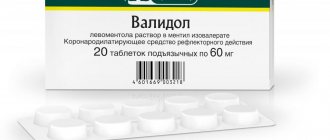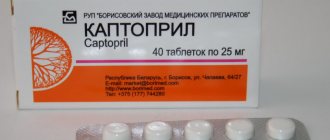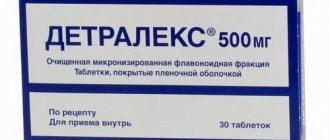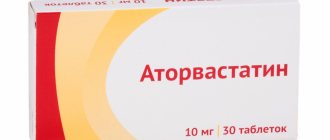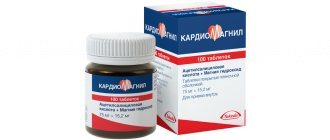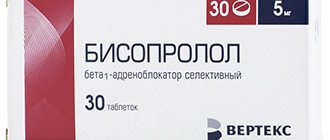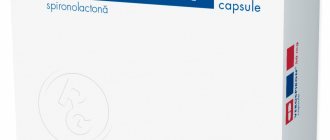Beta-agonists are effective in the presence of coronary heart disease, hypoglycemic coma, and bronchospasms. After entering the body, the components of the drug bind to beta-adrenergic receptors in the smooth muscles of the heart muscle, bronchi, uterus and vascular tissue.
The mechanism of action of this group of medications involves an effect on beta cells, due to which physiological processes are activated: the production of the hormone adrenaline and the neurotransmitter dopamine is stimulated.
After using beta-agonists, you can achieve an increase in blood pressure, an increase in the intensity of contraction of the heart muscle, and an improvement in bronchial conduction.
Physiological role of β-adrenergic receptors
Adrenaline is a universal adrenergic agonist, since it is responsible for stimulating all 4 subtypes of adrenergic receptors. Norepinephrine stimulates: 1, 2 and 1. 1-adrenergic receptors are under the control of dopamine. Additionally, this neurotransmitter stimulates its own dopaminergic receptors. Otherwise, the person’s condition gradually worsens.
Beta-adrenergic receptors are located in adipose tissue, the heart, and also in the renin-secreting cells that make up the juxtaglomerular apparatus of the nephrons of the kidneys. If they are excited, the heart begins to contract more often, and atrioventricular conduction increases.
All beta-agonists depend on cyclic adenosine monophosphate. As a result of the use of adrenergic stimulants in fatty tissue, the metabolic process of triglyceride breakdown is enhanced, thereby increasing the concentration of free fatty acids in the blood plasma.
Under such conditions, the kidneys synthesize renin (a protein-splitting enzyme) much better, resulting in the production of a peptide hormone and increased vascular tone. Beta adrenergic receptors are located in almost all organs. For example, in the heart, uterus, central nervous system, blood vessels.
Their stimulation allows you to gradually improve bronchial conductivity. B-adrenergic receptors increase the glucose level in the blood and reduce the tone of the uterus, which is very important during the period of bearing a child.
Classification
All drugs of the beta-2-adrenergic receptor group can be divided according to the selectivity of their action into β 2-adrenergic receptors. Non-selective drugs that, in addition to β 2 -adrenergic receptors, also act on β 1 -adrenergic receptors (including adrenergic receptors located in the myocardium, blood vessels and other organs), and have a short period of action, include isoprenaline, orciprenaline and hexoprenaline . Selective β 2 -agonists are divided according to the duration of action into short-acting drugs, which include salbutamol (as well as the levorotatory isomer of salbutamol - levosalbutamol), fenoterol and terbutaline. Long-acting β 2 -adrenergic receptors include salmeterol, formoterol, clenbuterol and bambuterol. There are also β 2 -adrenergic stimulants with ultra-trival action, the first representative of which is indacaterol.
What are B-adrenergic agonists?
The category of B-agonists includes various medications that are used in modern medicine to combat diseases of the cardiovascular system and respiratory tract. In the patient’s body, the components of the drug bind to beta receptors, a large number of which are found in the heart muscle, vascular tissue, and bronchial muscles.
Due to this, cell stimulation occurs and important physiological processes are activated. But it is prohibited to take such medications on your own , since an effective treatment regimen is selected for each patient individually.
With the use of B-agonists, tachycardia develops, which significantly reduces the likelihood of using these drugs to relieve bronchospasm. But selective beta-2 agonists have received huge demand in the treatment of bronchial asthma and other obstructive pulmonary diseases. For example, emphysema, chronic bronchitis.
Pharmacokinetics
Most β 2 -adrenergic receptor drugs are well absorbed when administered orally, but the oral bioavailability of adrenergic stimulants is low due to the presence of a first-pass effect through the liver in the metabolism of these drugs. The main route of use of the group’s drugs is inhalation, in which, for various forms of use (via a nebulizer, inhalation of a dry powder or aerosol), the bioavailability of the drugs ranges from 5 to 38%. The exception is the ultra-trivalent drug indacaterol, whose bioavailability when administered in inhalation is 43%. Some of the drugs in the group are also used parenterally, mainly intravenously, and the bioavailability of the drugs is 100%. Drugs of this group bind poorly to plasma proteins (on average 14-25%). Most drugs from the β 2 -adrenergic receptor group create high concentrations in most body tissues, penetrate the placental barrier and are excreted into breast milk. Drugs of the group are metabolized mainly in the liver, as well as in other tissues of the body under the action of MAO enzymes and catechol-O-methyltransferase. The half-life of the drugs in this group varies from 2 minutes for isoprenaline to 24 hours for indacaterol. β 2 -adrenergic stimulants are excreted from the body both in urine and feces, partly in the form of inactive metabolites, partly in unchanged form.
Mechanism of action in the body
Existing beta-agonists are divided into B1- and B2-agonists. When interacting with receptors, these drugs activate many physiological processes in the body.
Beta-agonists have the following properties:
- Increases blood pressure. This effect is due to stimulation of the RAAS.
- They improve the conductivity and automatism of the heart muscle (the ability to contract rhythmically without any visible irritation under the influence of impulses arising in the organ itself).
- Accelerate lipolysis. As a result of regular use of B1-adrenergic stimulants, fatty acids are formed in the patient’s blood.
- Increases the rhythm and strength of heart contractions.
All these changes in the patient’s body occur against the background of adrenergic stimulants binding to B1 receptors. They are found not only in the heart, blood vessels and fatty tissue, but also in the periglomerular cells of the kidneys.
Beta-adrenergic agonists, mechanism of action.
B2-adrenergic agonists have the following mechanism of action:
- They accelerate glycogenolysis in muscles, due to which skeletal muscles contract much faster.
- Improves bronchial conductivity. This effect is due to the gradual relaxation of smooth muscles.
- Glycogenolysis accelerates in liver cells, which increases the concentration of glucose in the blood.
- The uterine myometrium relaxes.
B-agonists have a wide range of applications. When used correctly, medications from this category can help get rid of the painful symptoms of diagnosed diseases, significantly improving the patient’s quality of life.
pharmachologic effect
β1-Adrenergic agonists stimulate β1-adrenergic receptors in the myocardium, which leads to an increase in the strength and frequency of heart contractions (and, as a consequence, cardiac output and blood pressure).
β2-Adrenergic agonists stimulate β2-adrenergic receptors in the bronchi, providing a bronchodilator (bronchodilator) effect, and also, due to stimulation of β2-adrenergic receptors of the uterus, have a tocolytic effect (relax the muscles of the uterus).
β3-Adrenergic agonists stimulate β3-adrenergic receptors in the bladder, relaxing its muscles and preventing urinary incontinence.
Advantages and disadvantages
Beta-adrenergic agonists (the mechanism of action of these drugs involves stimulation of beta cells in the human body, which has a positive effect on the functioning of internal organs) are sold in the form of solutions for intravenous administration and inhalation, powders, and tablets.
If the patient is prescribed inhalation, then only 20% of the total dose will reach the lungs. The dosage of the drug depends on the form of the diagnosed pathology and the patient’s condition.
B-adrenergic agonists have the following positive characteristics:
- Tones blood vessels.
- Beta-agonists may be prescribed to patients with low HDL cholesterol.
- Produces an anticoagulation effect.
- The drugs are highly effective when the content of triglycerides in the patient’s body is high.
- Stops the inflammatory process.
- Effective in the presence of metabolic syndrome.
- Fight free radicals.
Long-term treatment with B-adrenomimetics reduces the concentration of lipoproteins in the blood and also improves the condition of blood vessels.
Beta-agonists can provoke the development of adverse reactions, which is why before using the drug you need to make sure there are no contraindications.
Among the main disadvantages of this category of drugs is that they often cause vomiting, diarrhea, and flatulence in patients. In some cases, the emotional state may worsen, and depression may develop.
Prohibited use by athletes
Some drugs from the group of beta-2 adrenergic receptors, namely salbutamol, salmeterol and formoterol, are prohibited for use by athletes during competitions by decision of the World Anti-Doping Agency as stimulants of the respiratory system, and clenbuterol also as a drug with an anabolic effect. And identification of these drugs in the body of athletes during competitions may cause their disqualification. But some athletes suffering from bronchial asthma have permission to use salbutamol, formoterol and salmeterol (but not clenbuterol) from the World Anti-Doping Agency.
Classification of beta-agonists, types of medications
Beta-adrenergic agonists (the mechanism of action of drugs in this category allows one to cope with atrial fibrillation, which is the most complex form of cardiac arrhythmia) are usually divided into several groups.
There are 3 categories of B-agonists:
- Selective beta-1 adrenergic agonists. These drugs are in great demand in intensive care and cardiology departments.
- Non-selective beta-agonists.
- Selective B2-adrenergic agonists. Medicines from this category are in great demand in the fight against pathologies that affect the respiratory system. Drugs can have both a short and long-term principle of action.
Non-selective adrenergic stimulants are used in a short course to improve atrioventricular conduction and increase heart rate during bradycardia. Medications can achieve a positive inotropic effect. Some drugs are taken in a short course for acute heart failure, which is associated with myocarditis and myocardial infarction.
Uncontrolled use of drugs increases the likelihood of patient death.
To quickly eliminate attacks in chronic respiratory diseases, B-2 adrenergic agonists are used. Terbutaline or Fenoterol is administered intravenously to the patient to gradually reduce the intensity and frequency of contractions of the muscular structures of the uterus, when there is a high threat of premature birth.
Drugs in this category are often combined in one bottle with glucocorticosteroids to combat asthma.
Classification of adrenergic agonists
All alpha and beta adrenergic agonists, according to the mechanism of action on synapses, are divided into substances of direct, indirect and mixed action:
| Type of medication | Operating principle | Examples of medicines |
| Selective (direct) adrenergic agonists | Direct-acting adrenergic agonists contain adrenoreceptor agonists, which have an effect on the postsynaptic membrane similar to endogenous catecholamines (adrenaline and norepinephrine). | Mezaton, Dopamine, Adrenaline, Noradrenaline. |
| Non-selective (indirect) or sympathomimetics | Non-selective agents act on the vesicles of the presynaptic membrane of the adrenergic receptor, by increasing the synthesis of natural mediators in it. In addition, the adrenomimetic effect of these drugs is due to their ability to reduce the deposition of catecholamines and inhibit their active reuptake. | Ephidrine, Phenamine, Naphthyzin, Tyramine, Cocaine, Pargyline, Entacapone, Sydnofen. |
| Mixed action | Mixed-type drugs are both adrenergic receptor agonists and mediators of the release of endogenous catecholamines in α and β receptors. | Phenylephrine, Metasone, Norepinephrine, Epinephrine. |
Indications for the use of B-adrenergic agonists
Beta-adrenergic agonists (the mechanism of action of medications due to a gradual increase in the tone of blood vessels allows one to achieve an anti-shock effect) of a non-selective principle of action are quite rarely used in modern medicine. Previously, these drugs were used to normalize heart rhythm and improve cardiac conduction.
But in laboratory conditions, specialists were able to determine that selective B-agonists are no less effective, but at the same time cause fewer adverse reactions. These medications are more practical to use, since the components they contain act only on the damaged organ.
Among the main indications for the use of beta-agonists are the following diseases and conditions:
- Hypoglycemic coma.
- Severe form of coronary heart disease (CHD).
- Inflammatory diseases of the mucous membrane of the visual apparatus and nose.
- Glaucoma.
- Acute heart failure.
- Collapse (a life-threatening condition characterized by a drop in blood pressure and deterioration of blood supply to vital organs).
- Shock of various etiologies, a drop in blood pressure to a critical level, sudden cardiac arrest.
- Bronchial asthma and other diseases of the respiratory system that are accompanied by bronchospasm.
- Conducting local anesthesia.
- Decompensated heart defects.
Short-term use of beta-2 adrenergic agonists by healthy people can achieve a short-term increase in physical endurance.
This effect is due to the fact that the components of medications improve the functioning of the bronchi, which makes it easier for the body to cope with stress. B2-agonists are often used by professional athletes (for example, cyclists).
Alpha adrenergic agonists
Alpha adrenergic agonists are represented by drugs that act mainly on alpha adrenergic receptors, and they can be selective (only on one type) and non-selective (acting on both α1 and α2 molecules). Norepinephrine, which also stimulates beta receptors, is considered a non-selective drug.
Selective alpha1-adrenergic agonists include mezatone, etilephrine, and midodrine.
Drugs in this group have a good anti-shock effect by increasing vascular tone and spasm of small arteries, therefore they are prescribed for severe hypotension and shock. Their local use is accompanied by vasoconstriction; they can be effective in the treatment of allergic rhinitis and glaucoma.
Drugs that excite alpha2 receptors are more common
due to the possibility of predominantly local use. The most famous representatives of this class of adrenergic agonists are naphthyzine, galazolin, xylometazoline, and visine. These drugs are widely used to treat acute inflammatory processes of the nose and eyes. Indications for their use include allergic and infectious rhinitis, sinusitis, and conjunctivitis.
Due to the rapid onset of the effect and the availability of these drugs, they are very popular as medicines that can quickly relieve such an unpleasant symptom as nasal congestion. However, you should be careful when using them, because with excessive and prolonged use of such drops, not only drug resistance develops, but also atrophic changes in the mucosa, which can be irreversible.
The possibility of local reactions in the form of irritation and atrophy of the mucous membrane, as well as systemic effects (increased pressure, changes in heart rhythm) does not allow their long-term use, and they are also contraindicated for infants, people with hypertension, glaucoma, and diabetes. It is clear that both hypertensive and diabetic patients still use the same nasal drops as everyone else, but they should be very careful. Special products are produced for children that contain a safe dose of adrenergic agonists, and mothers must ensure that the child does not get an excess amount of them.
Selective centrally acting alpha2-adrenergic agonists
not only have a systemic effect on the body, they can pass through the blood-brain barrier and activate adrenergic receptors directly in the brain. Their main effects are:
- Reduce blood pressure and heart rate;
- Normalizes heart rate;
- They have a sedative and pronounced analgesic effect;
- Reduce the secretion of saliva and tear fluid;
- Reduce the secretion of water in the small intestine.
Methyldopa, clonidine, guanfacine, catapresan, dopegit are widely used
, which are used in the treatment of arterial hypertension. Their ability to reduce salivary secretion, provide an anesthetic effect and soothe allows them to be used as additional drugs during anesthesia and as anesthetics during spinal anesthesia.
Contraindications
Beta-agonists cannot be used in all patients. Non-selective B-agonists have the most contraindications for use. These drugs may cause tremor, hyperglycemia, tachycardia, and central nervous system excitation.
The mechanism of action of B-agonists is based on stimulation of beta receptors, which allows to achieve tocolytic, bronchodilator and inotropic effects. Properly selected medications help reduce the intensity of the release of inflammatory mediators by mast cells and basophils, thereby increasing the lumen of the bronchi.
Beta-1 adrenergic agonists belong to the category of potent drugs, which is why only a qualified doctor can prescribe them. They are not used if the patient has subaortic stenosis, ventricular arrhythmia and pheochromocytoma. B1-agonists should not be used for cardiac tamponade.
Before using beta-2 adrenergic agonists, the following contraindications should be taken into account:
- Diabetes.
- Individual intolerance to beta-agonists.
- Children's age (up to 2 years).
- The presence of inflammatory processes in the myocardium.
- Heart rhythm disturbance.
- Pregnancy, which is complicated by placental abruption, internal bleeding, and the threat of premature birth.
- Thyrotoxicosis.
- Aortic stenosis.
- Kidney, liver failure.
- Arterial hypertension.
Beta-agonists are prescribed with caution to patients who are taking medications for dry cough. β-agonists should not be used in acute kidney disease (eg, aldosteronism).
Modern beta-2 adrenergic agonists are well tolerated by patients in 98% of all cases. Due to the reduced risk of adverse reactions and the possibility of reducing the minimum dosage, drug therapy can achieve good results in the fight against decompensated heart defects.
Adrenergic agonists of indirect action
In addition to agents that directly bind to adrenergic receptors, there are others that indirectly have their effect by blocking the breakdown of natural mediators (adrenaline, norepinephrine), increasing their release, and reducing the reuptake of “excess” amounts of adrenergic stimulants.
Among the indirect adrenergic agonists, ephedrine, imipramine, and drugs from the group of monoamine oxidase inhibitors are used.
The latter are prescribed as antidepressants.
Ephedrine is very similar in action to adrenaline, and its advantages are the possibility of oral administration and a longer lasting pharmacological effect. The difference lies in the stimulating effect on the brain, which is manifested by excitement and an increase in the tone of the breathing center. Ephedrine is prescribed to relieve attacks of bronchial asthma, hypotension, shock, and local treatment for rhinitis is possible.
The ability of some adrenergic agonists to penetrate the blood-brain barrier and have a direct effect there allows them to be used in psychotherapeutic practice as antidepressants. Widely prescribed monoamine oxidase inhibitors prevent the destruction of serotonin, norepinephrine and other endogenous amines, thereby increasing their concentration at the receptors.
Nialamid, tetrindole, and moclobemide are used to treat depression. Imipramine, which belongs to the group of tricyclic antidepressants, reduces the reuptake of neurotransmitters, increasing the concentration of serotonin, norepinephrine, and dopamine at the site of transmission of nerve impulses.
Adrenergic agonists not only have a good therapeutic effect in many pathological conditions, but are also very dangerous due to some side effects, including arrhythmias, hypotension or hypertensive crisis, psychomotor agitation, etc., therefore drugs of these groups should be used only as prescribed by a doctor. They should be used with extreme caution by persons suffering from diabetes mellitus, severe cerebral atherosclerosis, arterial hypertension, and thyroid pathology.
Side effects
Beta-adrenergic agonists (the mechanism of action of drugs allows one to enhance the functioning of B-receptors of vascular walls and internal organs, which helps improve cardiac conduction) in isolated cases can worsen the patient’s condition. Most often this occurs as a result of non-compliance with the treatment regimen recommended by the attending physician.
B-adrenergic agonists can cause the following adverse reactions:
- Neurotoxic complications. As a result of the use of Ephedrine and Adrenaline, the patient may experience: insomnia, agitation, tremors of the limbs, acute headaches, discomfort in the heart area.
- Sudden vasoconstrictor action. A stroke, hypertensive crisis, acute heart failure with subsequent development of pulmonary edema may occur.
- Arrhythmogenic effect, which is fraught with various heart rhythm disturbances.
- Pupil dilation.
- Abnormal stool.
- Dry mouth.
- Development of allergic reactions.
- Nausea, vomiting.
If adverse reactions occur, the patient should stop taking the drug and seek advice from their doctor in order to choose a safer analogue.
Overdose
Cases of overdose with beta-agonists in medical practice are extremely rare. Due to a significant excess of the recommended dosage of the drug, the patient may experience the following symptoms.
Scroll:
- Nausea, vomiting.
- Diarrhea.
- Tachycardia.
- Worsening attacks of suffocation (lung closure syndrome).
- Headache.
- Hypokalemia.
- Increased sweating.
- Increased fatigue.
- Myalgia.
- Urinary retention.
- Confusion.
- Increased body temperature.
- Paradoxical bronchospasm.
- Chills.
- Coughing attacks.
- Itching and burning of the skin, Quincke's edema.
If the patient inadvertently took a large dose of the drug, then you need to rinse the stomach and take an effective sorbent (for example, activated carbon). To reduce the likelihood of deterioration in health, the patient should seek qualified help from the attending physician, who, if necessary, will prescribe symptomatic treatment.
Precautions and special instructions
Beta-agonists can be prescribed with caution to patients diagnosed with severe cardiovascular diseases, hyperthyroidism, prostatic hypertrophy and urinary tract obstruction. If a patient develops rapidly progressing shortness of breath, it is necessary to immediately seek medical help.
Symptomatic treatment may be more effective than regular use of B-agonists in those patients diagnosed with bronchial asthma or a moderate form of chronic obstructive pulmonary pathology. Additionally, increased anti-inflammatory therapy may be necessary to control airway inflammation.
In isolated cases, after using beta-agonists, patients are concerned about complications from the visual system. For example, an increase in intraocular pressure, the development of mydriasis and closed-angle glaucoma, acute pain in the eyeball. Such symptoms may occur after the drug comes into contact with the eyes.
To avoid negative consequences, the patient should carefully study the instructions before using beta-agonists in the form of aerosols.
If the patient has decreased visual acuity, pain in the eye and redness of the mucous membrane, then these symptoms may indicate an acute attack of angle-closure glaucoma. In this case, along with B-agonists, you need to use eye drops that will help narrow the pupil.
Before using the drug, you should consult an ophthalmologist. If the patient has a history of cystic fibrosis, then as a result of the use of beta-agonists, various disturbances in the functioning of the gastrointestinal tract may occur. In this case, the gastroenterologist will have to select a safe analogue.
List of drugs, dosage regimen, prices
Beta-agonists are in great demand in traditional medicine, as they are highly effective in the fight against cardiac and pulmonary pathologies.
Some drugs in this category are used in intensive care units. For example, Dobutamine. Various beta-agonists are in demand in gynecological practice.
Tablet forms of drugs
To combat bronchial asthma, cardiac crisis and other diseases, beta-agonists in the form of tablets for oral administration are often used. The treatment regimen and dosage depend on the patient's diagnosis and general condition.
| Drug name | Description | Average cost (RUB) |
| Salmo | Salbutamol is used as an active component. The drug is indicated for airway obstruction caused by bronchial asthma or chronic bronchitis. Adults and children over 12 years of age need to take the drug 2 tablets 3-4 times a day. The duration of treatment is determined individually. | 110 |
| Salbutamol | Salbutamol is added to the drug as the main active ingredient. The drug is indicated for all forms of bronchial asthma, reversible airway obstruction in chronic emphysema and bronchitis. Salbutamol is prescribed to pregnant women when there is a high risk of premature birth. It is recommended to take the drug 2-4 mg maximum 4 times a day. The duration of therapy is determined by the doctor. | 130 |
It is prohibited to use B-adrenergic agonists without prior examination and consultation with your doctor. Otherwise, the patient’s condition may worsen significantly, which will require more radical treatment.
Solutions for injections and inhalations
B-adrenergic agonists in the form of solutions with precise dosing are used to effectively relieve and prevent bronchospasm in chronic obstructive pulmonary disease and bronchial asthma. A large dosage of the drug is needed for pronounced swelling and inflammation of the mucous membrane of the respiratory tract.
| Drug name | Description | Average cost in Russia (RUB) |
| Astalin | Salbutamol sulfate is used as the active component. The drug is intended to prevent and relieve bronchospasm in bronchial asthma and emphysema. To obtain a positive therapeutic effect, adults and children over 12 years of age need to take 100-200 mcg of the drug (1-2 inhalation doses). The daily dosage of the drug should not exceed 1200 mcg. | 155 |
| Fenoterol | The active component of the solution is fenoterol. The drug is indicated for uterine hypertonicity, bronchial asthma, and spastic chronic bronchitis. In gynecology, the drug Fenoterol is prescribed to those women who are at risk of premature birth. When using the medicine by inhalation, the single dosage is 200 mcg. When administered intravenously, the initial dose should not exceed 50 mcg. The duration of treatment depends on the patient's condition. | 340 |
Before purchasing beta-agonists, you need to study the instructions and also consult with your doctor. In modern B2-agonists, the mechanism of action is associated with stimulation of beta-adrenergic receptors, due to which the bronchial muscles relax and the work of the heart muscle increases.
If you follow the recommended dosage and frequency of use of the drug, the likelihood of adverse reactions is virtually eliminated.
What drugs belong to the group of B-adrenergic agonists?
Doctors often prescribe beta-agonists. Drugs belonging to this pharmacological group are divided into short- and fast-acting medications. In addition, there are drugs that have a selective effect only on certain organs. Some drugs act directly on B1 and B2 receptors. The most well-known medications from the group of beta-adrenergic agonists are the drugs “Salbutamol”, “Fenoterol”, “Dopamine”. β-agonists are used in the treatment of pulmonary and cardiac diseases. Also, some of them are used in the intensive care unit (the drug “Dobutamine”). Less commonly, drugs of this group are used in gynecological practice.



